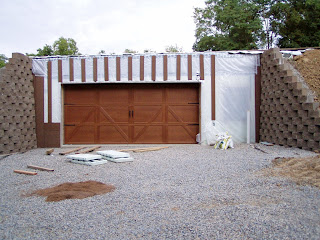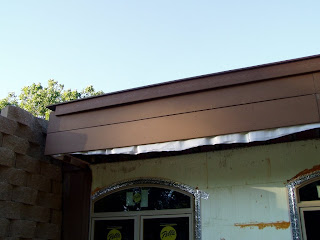I have been wanting to get the rest of the furring on the garage side, so it is ready for Hardie panel, and trim. Well, I worked on getting more furring up. It was slow work by myself, since I only have two hands. I needed a second person to hold the pieces in place, while I attached them. The remaining pieces were somewhat large and heavy to hold with one hand, while attaching with the other. I took some framing lumber that was laying around, and put it to work. I leaned it up against the furring strips, then I could concentrate on attaching them. This is much slower though, than having a helper. Here is how the work on the garage side proceeded:
A couple evenings working by myself, and I managed to get almost all the furring finished, and got the plastic flashed around the window.
Dad came out on a Saturday, and we got the rest of the Trex attached on that side.
Now ready for panels to be applied.
After we got the Trex on, we started working on cutting the foam for under the overhang. According to our plans at the time.
All the foam is cut according to the plans.
Something came up, and we had to leave earlier than we had planned. Last Monday dad and mom came out, and we started to install the foam, and put the Trex boards under it, and secure them to the joists, with the bolts we had prepared a while back. We got two pieces attached, and were working by flashlight. Things just weren't working out the way they were supposed to. To get the Trex into the proper position at the ends, we were having to tighten it enough, that the board was bowing in the middle. We were also having trouble getting the two boards to be level with respect to one another. I went out on Tuesday to look over the situation again. I took a string and strung it from the bottom of the joists on one end, to the bottom of the joists at the other end, just inside the front boards. When the string was level, it would only touch the two joists it was attached to. Some of the joist ends were over an inch higher than the string. I moved the string over next to the house wall, and there were only small differences in the location of the joist bottoms. Hmmm, what is going on with these joists.
Yes, the bottom of the joists are not straight, they bow upwards!
Ok, since the bottoms of the joists are not straight, it will not be possible to have the Trex boards be straight if they and the foam are snugged up to the bottom of joists. Time for yet another change to plans.
Dad and I had some ideas we batted around. I think we now have the new plan put together. The other evening I replaced the board at the front door, that Doug had put in place when they poured the concrete floor. I wanted to have a little insulation and use something that wouldn't rot. I measured and with dad's help, installed a trex board in place of the wood board.
The board is attached to the house on both ends. The boards pushing against the middle, were just there for while the spray foam set up.
Since I was going to have to order some parts to work the new plan for the overhang, I decided we should get the roof box finally finished. To install the roof box and seal it up, was rather complex, and took us all Saturday (starting around 8:30 and going until almost dark), and working a few hours this afternoon. I knew this was going to be an involved and time consuming process, and I wanted to make sure we had enough time to do it right, and not get it half way done, and then have to stop, and worry about rain coming in and leaking in through unfinished waterproofing.
Preparations for installing the roof box, started back in June, when I had cut the roof deck. This weekend I turned that hole through the roof deck, briefly into a skylight. I hated the idea of cutting through the waterproofing layers that have been working so well. But certain code requirements dictate that certain things have to go through the roof.
The utility room had a skylight this weekend.
We ran a long drill bit up through the foam, and the waterproofing, from the inside, to show where the hole needed to be cut. Then we cut the waterproofing from on top. That small hole let in a lot of light. If it weren't for the concerns over trying to leakproof a roof like this, and the cost, I would certainly like to have skylights in a few places in the house.
After we had the initial hole cut through the drainage, waterproofing, and foam, we had to expand the hole in the foam to accommodate the roof box. The roof box position, was dicated by only one of the pipes that was going to run through it. The vent for the plumbing system, was set in the concrete of the floor, and it was best if the pipe going through the roof extended directly above it. When the framer built the wall separating the garage and utility room, he put three boards at the top of it, then extended it with a short wall section up to the joists. That extra extension of the wall, was going to get in the way of putting the pipes in, and it didn't provide any required structural support to the wall. So we cut out a section to make the work a bit easier.
The reciprocating saw, has come in handy.
We took out a small piece of the third board on the top of the wall as well.
The wall is not load bearing, three boards was really a bit much. You can see where we cut a hole for the vent pipe to go through. Back up on the roof, we dropped the pipe that would be going up through, down the hole. We still had some more roof deck to cut to clear the pipe. Once we got that cut, we positioned the roof box. Then we cut the drainage, waterproofing and foam back so the box could fit down onto the roof deck.
Roof box inserted in place. We had a very good fit!
After we had the box inserted, we attached it with screws to the roof deck. The first thing we did to restore the waterproofing, was to bring the plastic up the sides of the box, and seal up the corners.
Using flashing tape to turn the plastic into flashing.
The plastic is thoroughly taped and the drainage material is brought back in to the box.
The next step was to make sure that water that came down the sides, would run down onto the drainage material, and not even get to the plastic waterproofing. To do this, we took a strip of aluminum flashing, and covered the sides and directed the bottom out onto the drainage. In the picture above, dad was cutting the corners of the flashing material we had fashioned to go around the box.
Box is wrapped!
We applied flashing tape around the bottom of the box to encourage water to flow out onto the drainage material.
We covered it up, to keep out curious critters, and called it a day. Then this afternoon, we worked to get the pipes installed, and the cap on the box. I had gotten a sheet of aluminum for us to make the cap for the box. We bent the sheet using some left over framing material and a piece of wood that had been used for delivering the steel joists! We used the tailgate of the truck as our workbench.
It turned out quite nicely, and had a very good fit.
After we had the cap made, we cut holes in the top for the pipes to go through. We put a piece of Trex in the top of the box, to provide support for the cap. Then we installed the various vents. With putting the dirt bags back in place, putting some bricks and sand around the base, here is how it turned out.
Dryer vent one the left, water heater vent, and the plumbing vent.
When the rooftop landscaping is finished, even less of the box will show. Only the top third of the original box will be above ground.
























